Grain Refinement and Improved Mechanical Properties of EUROFER97 by Thermo-Mechanical Treatments
Abstract
1. Introduction
2. Materials and Methods
3. Results and Discussion
3.1. Work-Hardening Behavior of EUROFER97 Steel
3.2. Recrystallization Behavior of EUROFER97 Steel
4. Conclusions
Author Contributions
Funding
Institutional Review Board Statement
Informed Consent Statement
Data Availability Statement
Acknowledgments
Conflicts of Interest
References
- Rieth, M.; Schirra, M.; Falkenstein, A.; Graf, P.; Heger, S.; Kempe, H.; Lindau, R.; Zimmermann, H. EUROFER 97 Tensile, Charpy, Creep and Structural Tests; Report FZKA6911, Eurofusion Programme; Forschungzentrum Karlsruhe g.m.b.h.: Karlsruhe, Germay, 2003. [Google Scholar]
- Zilnyk, K.D.; Oliveira, V.B.; Sandim, H.R.Z.; Möslang, A.; Raabe, D. Martensitic transformation in Eurofer-97 and ODS-Eurofer steels: A comparative study. J. Nucl. Mater. 2015, 462, 360–367. [Google Scholar] [CrossRef]
- Huang, Q.; Baluc, N.; Dai, Y.; Jitsukawa, S.; Kimura, A.; Konys, J.; Kurtz, R.J.; Lindau, R.; Muroga, T.; Odette, G.R.; et al. Recent progress of R&D activities on reduced activation ferritic/martensitic steels. J. Nucl. Mater. 2013, 442, 2–8. [Google Scholar]
- Sahoo, K.C.; Vanaja, J.; Parameswaran, P.; Vijayanand, V.D.; Laha, K. Effect of thermal ageing on microstructure, tensile and impact properties of reduced activated ferritic-martensitic steel. Mater. Sci. Eng. A 2017, 686, 54–64. [Google Scholar] [CrossRef]
- Mao, C.; Liu, C.; Yu, L.; Li, H.; Liu, Y. Mechanical properties and tensile deformation behavior of a reduced activated ferritic-martensitic (RAFM) steel at elevated temperatures. Mater. Sci. Eng. A 2018, 725, 283–289. [Google Scholar] [CrossRef]
- Donné, T. European Research Roadmap to the Realisation of Fusion Energy. In Proceedings of the 30th Symposium on Fusion Technology, Sicily, Italy, 16–21 September 2018. [Google Scholar]
- Zinkle, S.J.; Möslang, A. Evaluation of irradiation facility options for fusion materials research and development. Fusion Eng. Des. 2013, 88, 472–482. [Google Scholar] [CrossRef]
- Kohyama, A.; Hishinuma, A.; Gelles, D.S.; Klueh, R.L.; Dietz, W.; Ehrlich, K. Low-activation ferritic and martensitic steels for fusion application. J. Nucl. Mater. 1996, 233–237, 138–147. [Google Scholar] [CrossRef]
- Di Schino, A.; Testani, C.; Pilloni, L. Effect of thermo-mechanical parameters on the mechanical properties of Eurofer97 steel for nuclear applications. Open Eng. 2018, 8, 349–353. [Google Scholar] [CrossRef]
- Chen, J.; Liu, C.; Liu, Y.; Yan, B.; Li, H. Effects of tantalum content on the microstructure and mechanical properties of low-carbon RAFM steel. J. Nucl. Mater. 2016, 479, 295–301. [Google Scholar] [CrossRef]
- Chen, J.; Liu, Y.; Liu, C.; Yan, B.; Li, H. Effects of tantalum on austenitic transformation kinetics of RAFM steel. J. Iron Steel Res. Int. 2017, 24, 705–710. [Google Scholar] [CrossRef]
- Tavassoli, A.A.F.; Diegele, E.; Lindau, R.; Luzginova, N.; Tanigawa, H. Current status and recent research achievements in ferritic/martensitic steels. J. Nucl. Mater. 2014, 455, 269–276. [Google Scholar] [CrossRef]
- Mergia, K.; Boukos, N. Structural, thermal, electrical and magnetic properties of Eurofer 97 steel. J. Nucl. Mater. 2008, 373, 1–8. [Google Scholar] [CrossRef]
- Tavassoli, A.A.F.; Alamo, A.; Bedel, L.; Forest, L.; Gentzbittel, J.M.; Rensman, J.W.; Diegele, E.; Lindau, R.; Schirra, M.; Schmitt, R.; et al. Materials design data for reduced activation martensitic steel type EUROFER. J. Nucl. Mater. 2004, 329–333, 257–262. [Google Scholar] [CrossRef]
- Hoffmann, J.; Rieth, M.; Commin, L.; Fernández, P.; Roldán, M. Improvement of reduced activation 9%Cr steels by ausforming. Nucl. Mater. Energy 2016, 6, 12–17. [Google Scholar] [CrossRef]
- Stornelli, G.; Rallini, M.; Testani, C.; Montanari, R.; Di Schino, A. Effetto di trattamenti termomeccanici su acciaio EUROFER97 per applicazioni in reattori a fusione nucleare. La Metall. Ital. 2020, 112, 34–44. [Google Scholar]
- Chen, X.; Bhattacharya, A.; Sokolov, M.A.; Clowers, L.N.; Yamamoto, Y.; Graening, T.; Linton, K.D.; Katoh, Y.; Rieth, M. Mechanical properties and microstructure characterization of Eurofer97 steel variants in EUROfusion program. Fusion Eng. Des. 2019, 146, 2227–2232. [Google Scholar] [CrossRef]
- Gaganidze, E.; Gillemot, F.; Szenthe, I.; Gorley, M.; Rieth, M.; Diegele, E. Development of EUROFER97 database and material property handbook. Fusion Eng. Des. 2018, 135, 9–14. [Google Scholar] [CrossRef]
- Montanari, R.; Filacchioni, G.; Iacovone, B.; Plini, P.; Riccardi, B. High temperature indentation tests on fusion reactor candidate materials. J. Nucl. Mater. 2007, 367–370, 648–652. [Google Scholar] [CrossRef]
- Stornelli, G.; Montanari, R.; Testani, C.; Pilloni, L.; Napoli, G.; Di Pietro, O.; Di Schino, A. Microstructure Refinement Effect on EUROFER 97 Steel for Nuclear Fusion Application. Mater. Sci. Forum 2021, 1016, 1392–1397. [Google Scholar] [CrossRef]
- Puype, A.; Malerba, L.; De Wispelaere, N.; Petrov, R.; Sietsma, J. Effect of processing on microstructural features and mechanical properties of a reduced activation ferritic/martensitic EUROFER steel grade. J. Nucl. Mater. 2017, 494, 1–9. [Google Scholar] [CrossRef]
- Montanari, R.; Filacchioni, G.; Riccardi, B.; Tata, M.E.; Costanza, G. Characterization of EUROFER 97 TIG-welded joints by FIMEC indentation tests. J. Nucl. Mater. 2004, 1529, 329–333. [Google Scholar] [CrossRef]
- Lindau, R.; Möslang, A.; Rieth, M.; Klimiankou, M.; Materna-Morris, E.; Alamo, A.; Tavassoli, A.A.F.; Cayron, C.; Lancha, A.M.; Fernandez, P.; et al. Present development status of EUROFER and ODS-EUROFER for application in blanket concepts. Fusion Eng. Des. 2005, 75–79, 989–996. [Google Scholar] [CrossRef]
- Coppola, R.; Klimenkov, M. Dose Dependence of Micro-Voids Distributions in Low-Temperature Neutron Irradiated Eurofer97 Steel. Metals 2019, 9, 552. [Google Scholar] [CrossRef]
- Roldán, M.; Fernández, P.; Rams, J.; Sánchez, F.J.; Gómez-Herrero, A. Nanoindentation and TEM to Study the Cavity Fate after Post-Irradiation Annealing of He Implanted EUROFER97 and EU-ODS EUROFER. Micromachines 2018, 9, 633. [Google Scholar] [CrossRef] [PubMed]
- Fu, J.; Brouwer, J.; Hendrikx, R.; Richardson, I.; Hermans, M. Microstructure characterisation and mechanical properties of ODS Eurofer steel subject to designed heat treatments. Mater. Sci. Eng. A 2020, 770, 138568. [Google Scholar] [CrossRef]
- Testani, C.; Di Nunzio, P.E.; Salvatori, I. Manufacturing of ODS RAFM Steel: Mechanical and Microstructural Characterization. Mater. Sci. Forum 2016, 879, 1639–1644. [Google Scholar] [CrossRef]
- De Sanctis, M.; Fava, A.; Lovicu, G.; Montanari, R.; Richetta, M.; Testani, C.; Varone, A. Mechanical characterization of a nano-ODS steel prepared by low-energy mechanical alloying. Metals 2017, 7, 283. [Google Scholar] [CrossRef]
- Mateus, R.; Carvalho, P.A.; Nunes, D.; Alves, L.C.; Franco, N.; Correia, J.B.; Alves, E. Microstructural characterization of the ODS Eurofer 97 EU-batch. Fusion Eng. Des. 2011, 86, 2386–2389. [Google Scholar] [CrossRef][Green Version]
- Cabet, C.; Dalle, F.; Henry, J.; Gaganidze, E.; Tanigawa, H. Ferritic-martensitic steels for fission and fusion applications. J. Nucl. Mater. 2019, 523, 510–537. [Google Scholar] [CrossRef]
- De Sanctis, M.; Fava, A.; Lovicu, G.; Montanari, R.; Richetta, M.; Testani, C.; Varone, A. Temperature Dependent Mechanical Behavior of ODS Steels. Mater. Sci. Forum 2018, 941, 257–262. [Google Scholar] [CrossRef]
- Fava, A.; Montanari, R.; Richetta, M.; Testani, C.; Varone, A. Analysis of Strengthening Mechanisms in Nano-ODS Steel Depending on Preparation Route. J. Mater. Sci. Eng. 2018, 7, 2169. [Google Scholar] [CrossRef]
- Schaeublin, R.; Leguey, T.; Spätig, P.; Baluc, N.; Victoria, M. Microstructure and mechanical properties of two ODS ferritic/martensitic steels. J. Nucl. Mater. 2002, 307–311, 778–782. [Google Scholar] [CrossRef]
- Zhou, J.H.; Shen, Y.F.; Jia, N. Strengthening mechanisms of reduced activation ferritic/martensitic steels: A review. Int. J. Miner. Metall. Mater. 2021, 28, 335–348. [Google Scholar] [CrossRef]
- Gondi, P.; Montanari, R. On the Cr distribution in MANET steel. Phys. Stat. Solid. A 1992, 131, 465–480. [Google Scholar] [CrossRef]
- Fava, A.; Montanari, R.; Varone, A. Mechanical Spectroscopy Investigation of Point Defect-Driven Phenomena in a Cr Martensitic Steel. Metals 2018, 8, 870. [Google Scholar] [CrossRef]
- Bolli, E.; Fava, A.; Ferro, P.; Kaciulis, S.; Mezzi, A.; Montanari, R.; Varone, A. Cr Segregation and Impact Fracture in a Martensitic Stainless Steel. Coatings 2020, 10, 843. [Google Scholar] [CrossRef]
- Zhou, W.; Yu, J.; Lin, J.; Dean, T.A. Manufacturing a curved profile with fine grains and high strength by differential velocity sideways extrusion. Int. J. Mach. Tools. Manuf. 2019, 140, 77–88. [Google Scholar] [CrossRef]
- Zhou, W.; Yu, J.; Lu, X.; Lin, J.; Dean, T.A. A comparative study on deformation mechanisms, microstructures and mechanical properties of wide thin-ribbed sections formed by sideways and forward extrusion. Int. J. Mach. Tools. Manuf. 2021, 168, 103771. [Google Scholar] [CrossRef]
- Pickering, F.B.; Gladman, T. Metallurgical Developments in Carbon Steels; Special Report No. 81; Iron and Steel Institute: London, UK, 1963. [Google Scholar]
- Di Schino, A.; Alleva, L.; Guagnelli, M. Microstructure Evolution during Quenching and Tempering of Martensite in a Medium C Steel. Mater. Sci. Forum 2012, 715–716, 860–865. [Google Scholar] [CrossRef]
- Di Schino, A. Manufacturing and application of stainless steels. Metals 2020, 10, 327. [Google Scholar] [CrossRef]
- Beyerlein, I.J.; Caro, A.; Demkowicz, M.J.; Mara, N.A.; Misra, A.; Uberuaga, B.P. Radiation damage tolerant nanomaterials. Mater. Today 2013, 16, 443–449. [Google Scholar] [CrossRef]
- Song, M.; Wu, Y.D.; Chen, D.; Wang, X.M.; Sun, C.; Yu, K.Y.; Chen, Y.; Shao, L.; Yang, Y.; Hartwig, K.T.; et al. Response of equal channel angular extrusion processed ultrafine-grained T91 steel subjected to high temperature heavy ion irradiation. Acta Mater. 2014, 74, 285–295. [Google Scholar] [CrossRef]
- Di Schino, A.; Gaggiotti, M.; Testani, C. Heat Treatment Effect on Microstructure Evolution in a 7% Cr Steel for Forging. Metals 2020, 10, 808. [Google Scholar] [CrossRef]
- Mancini, S.; Langellotto, L.; Di Nunzio, P.E.; Zitelli, C.; Di Schino, A. Defect Reduction and Quality Optimization by Modeling Plastic Deformation and Metallurgical Evolution in Ferritic Stainless Steels. Metals 2020, 10, 186. [Google Scholar] [CrossRef]
- Cristalli, C.; Pilloni, L.; Tassa, O.; Bozzetto, L. Mechanical properties of several newly produced RAFM steels with Tungsten content in the range of 2 wt%. Nucl. Mater. Energy 2020, 25, 100793. [Google Scholar] [CrossRef]
- Cristalli, C.; Pilloni, L.; Tassa, O.; Bozzetto, L.; Sorci, R.; Masotti, L. Development of innovative steels and thermo-mechanical treatments for DEMO high operating temperature blanket options. Nucl. Mater. Energy 2018, 16, 175–180. [Google Scholar] [CrossRef]
- Oliveira, V.B.; Sandim, H.R.Z.; Raabe, D. Abnormal grain growth in Eurofer-97 steel in the ferrite phase field. J. Nucl. Mater. 2017, 485, 23–38. [Google Scholar] [CrossRef]
- Lan, H.F.; Liu, W.J.; Liu, X.H. Ultrafine ferrite grains produced by tempering cold-rolled martensite in low carbon and microalloyed steels. ISIJ Int. 2007, 47, 1652–1657. [Google Scholar] [CrossRef]
- Karthikeyan, T.; Thomas Paul, V.; Saroja, S.; Moitra, A.; Sasikala, G.; Vijayalakshmi, M. Grain refinement to improve impact toughness in 9Cr-1Mo steel through a double austenitization treatment. J. Nucl. Mater. 2011, 419, 256–262. [Google Scholar] [CrossRef]
- Pilloni, L.; Cristalli, C.; Tassa, O.; Salvatori, I.; Storai, S. Grain size reduction strategies on Eurofer. Nucl. Mater. Energy 2018, 17, 129–136. [Google Scholar] [CrossRef]
- Stornelli, G.; Di Schino, A.; Montanari, R.; Testani, C.; Varone, A.; Mancini, S. Work-Hardening Behavior of Cold Rolled EUROFER97 Steel for Nuclear Fusion Applications. Mater. Proc. 2021, 3, 21. [Google Scholar] [CrossRef]
- Williamson, G.K.; Smallman, R.E., III. Dislocation densities in some annealed and cold-worked metals from measurements on the X-ray Debye-Scherrer spectrum. Philos. Mag. 1956, 1, 34–46. [Google Scholar] [CrossRef]
- Gondi, P.; Montanari, R.; Sili, A. Small scale non-destructive stress-strain and creep tests feasible during irradiation. J. Nucl. Mater. 1994, 1688, 212–215. [Google Scholar]
- Riccardi, B.; Montanari, R.; Moreschi, L.F.; Sili, A.; Storai, S. Mechanical characterization of fusion materials by indentation test. Fusion Eng. Des. 2001, 755, 58–59. [Google Scholar]
- Klimenkov, M.; Lindau, R.; Materna-Morris, E.; Möslang, A. TEM characterization of precipitates in EUROFER 97. Prog. Nucl. Energy 2012, 57, 8–13. [Google Scholar] [CrossRef]
- Fernández, P.; Lancha, A.M.; Lapeña, J.; Hernández-Mayoral, M. Metallurgical characterization of the reduced activation ferritic/martensitic steel Eurofer’97 on as-received condition. Fusion Eng. Des. 2001, 58–59, 787–792. [Google Scholar] [CrossRef]
- JCPDS. International Centre for Diffraction Data; JCPDS: Newtown Square, PA, USA, 1907; Available online: https://www.icdd.com/ (accessed on 17 March 2021).




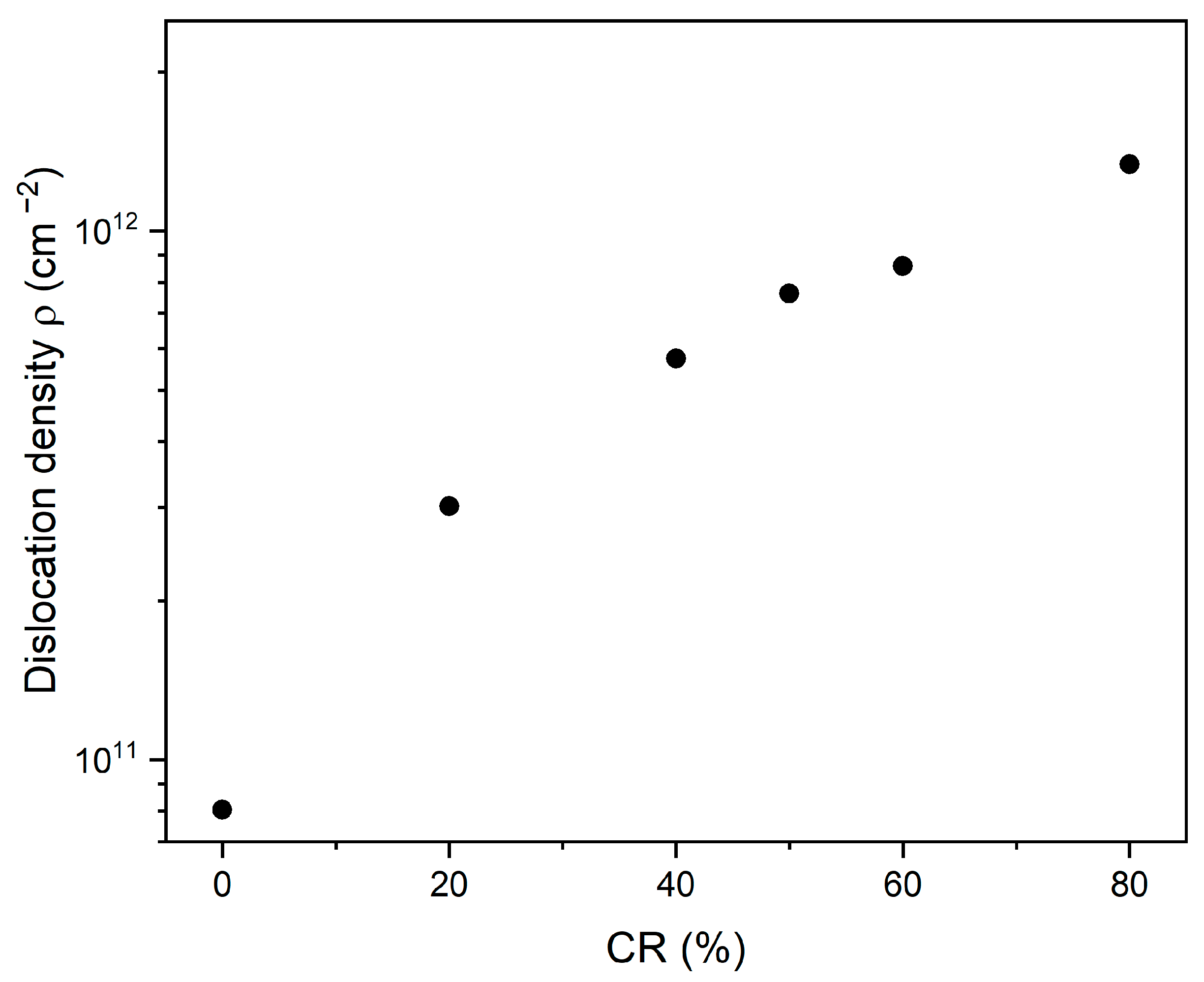
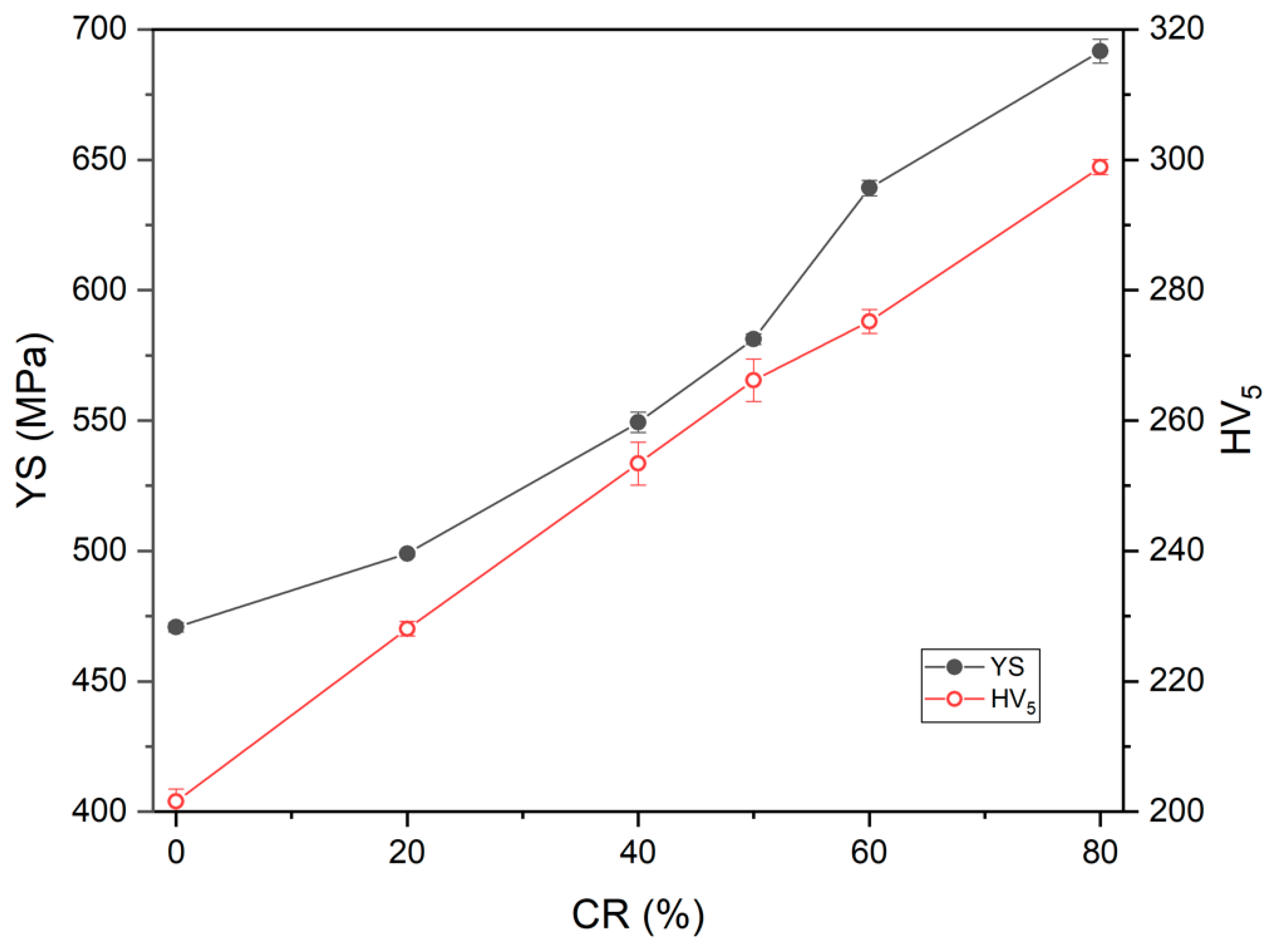
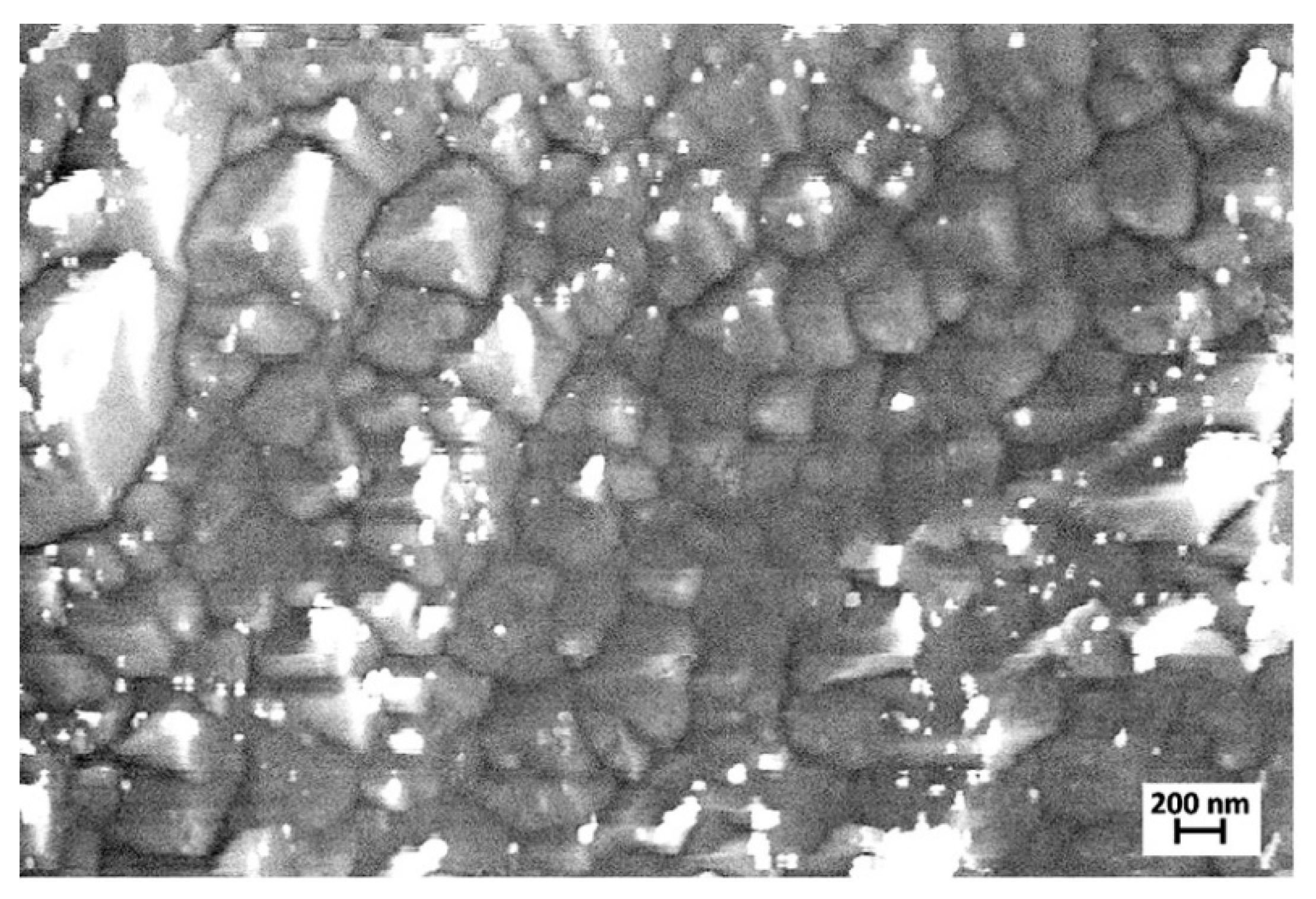


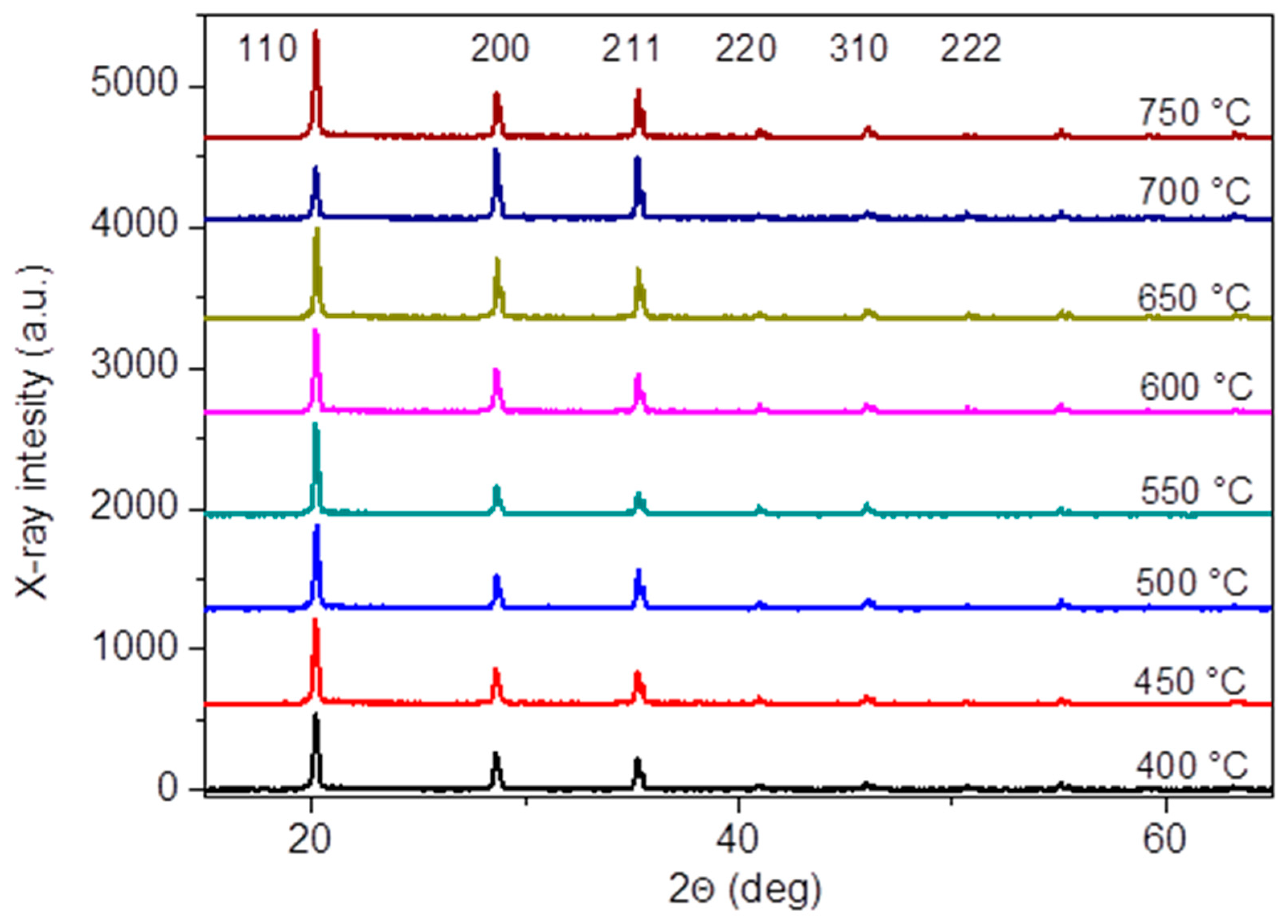

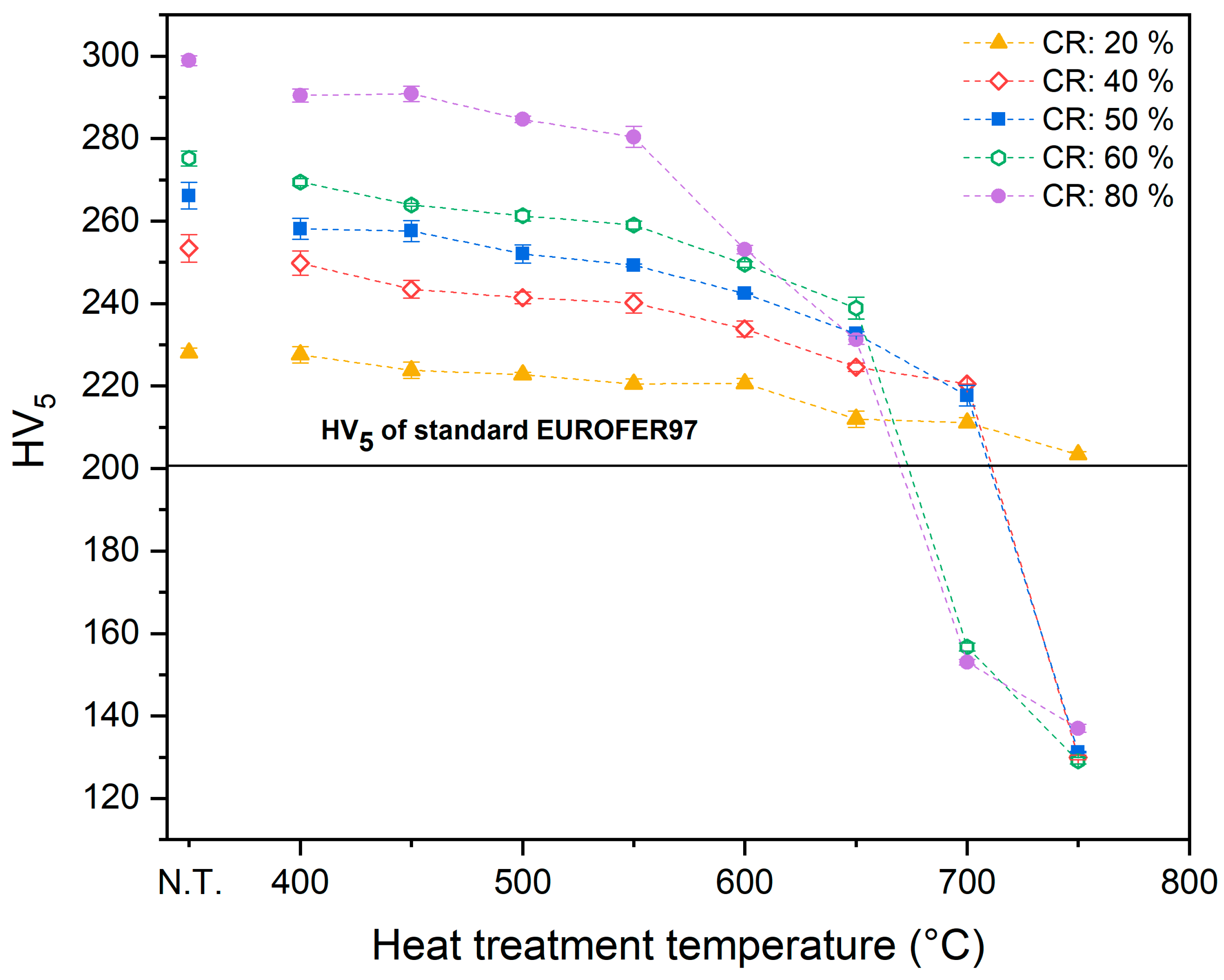
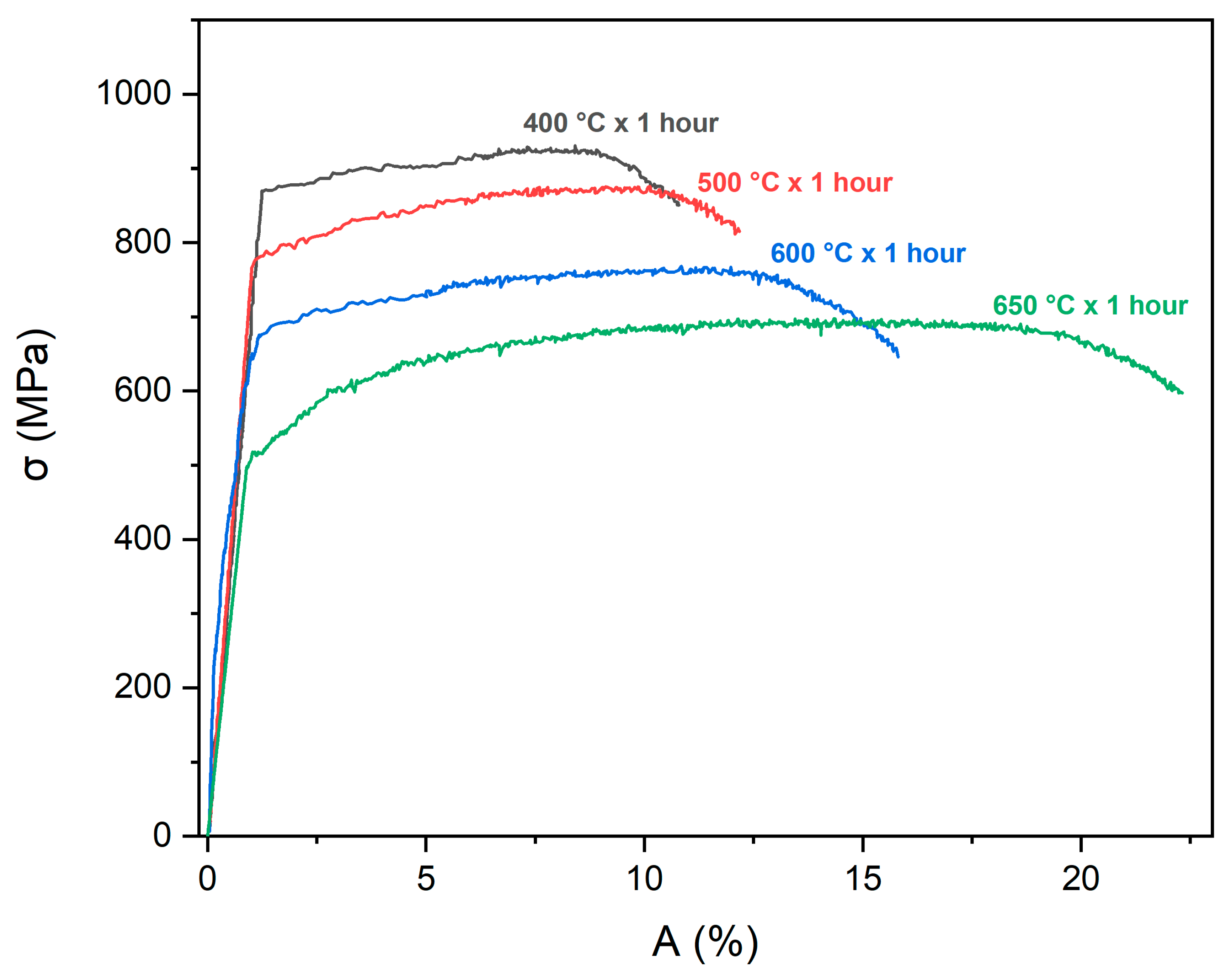
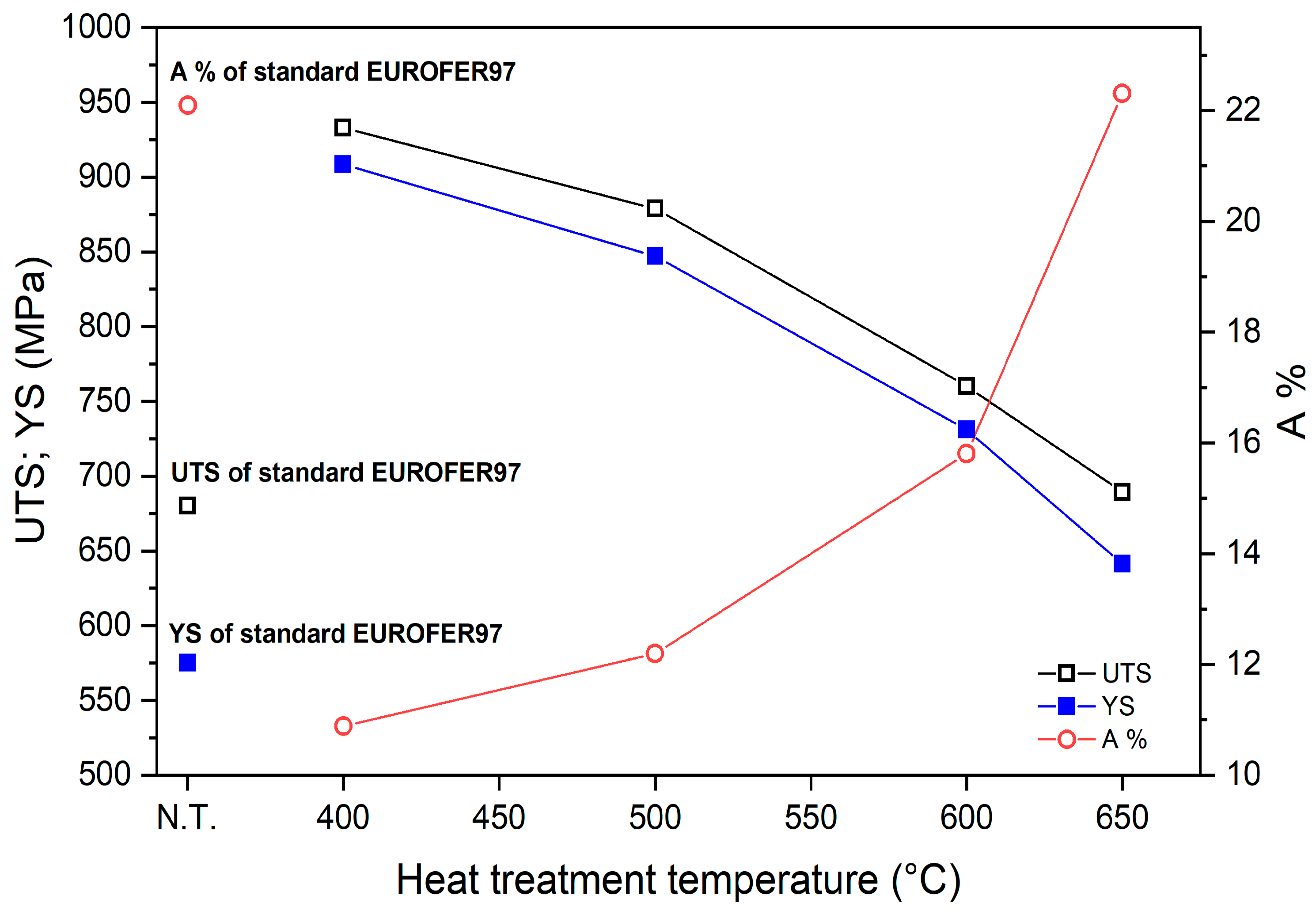
| Cr | C | Mn | V | W | Ta | Ti | N |
| 8.93 | 0.12 | 0.47 | 0.2 | 1.07 | 0.14 | 0.009 | 0.018 |
| P | S | B | Si | Nb | Mo | Ni | Cu |
| <0.005 | 0.004 | <0.001 | 0.006 | 0.002 | 0.0015 | 0.002 | 0.003 |
| Peaks | 110 | 200 | 211 | 220 | 310 | 222 |
|---|---|---|---|---|---|---|
| JCPDS database-file 6-696 | 100 | 20 | 30 | 10 | 12 | 6 |
| Standard | 100 | 11 | 20 | 8 | 6 | - |
| CR 20% | 100 | 24 | 27 | 6 | 9 | 5 |
| CR 40% | 100 | 15 | 38 | 6 | 7 | 4 |
| CR 50% | 100 | 7 | 12 | 5 | 4 | - |
| CR 60% | 100 | 20 | 30 | 1 | 1 | 1 |
| CR 80% | 100 | 52 | 63 | - | 1 | 1 |
| Peaks | 110 | 200 | 211 | 220 | 310 | 222 |
|---|---|---|---|---|---|---|
| JCPDS database-file 6-696 | 100 | 20 | 30 | 10 | 12 | 6 |
| Standard | 100 | 11 | 20 | 8 | 6 | - |
| CR 80%/not treated | 100 | 52 | 63 | - | 1 | 1 |
| CR 80%/400 °C | 100 | 48 | 42 | 8 | 10 | 1 |
| CR 80%/450 °C | 100 | 43 | 38 | 7 | 8 | 1 |
| CR 80%/500 °C | 100 | 41 | 28 | 7 | 8 | 1 |
| CR 80%/550 °C | 100 | 30 | 21 | 6 | 8 | 1 |
| CR 80%/600 °C | 100 | 52 | 45 | 9 | 8 | 3 |
| CR 80%/650 °C | 100 | 66 | 55 | 6 | 9 | 4 |
| CR 80%/700 °C | 73 | 100 | 89 | 6 | 10 | 9 |
| CR 80%/750 °C | 100 | 42 | 44 | 7 | 10 | 4 |
| CR Ratio % | 20 | 40 | 50 | 60 | 80 |
| Softening % | 10.8 | 48.7 | 50.7 | 53 | 54.2 |
Publisher’s Note: MDPI stays neutral with regard to jurisdictional claims in published maps and institutional affiliations. |
© 2021 by the authors. Licensee MDPI, Basel, Switzerland. This article is an open access article distributed under the terms and conditions of the Creative Commons Attribution (CC BY) license (https://creativecommons.org/licenses/by/4.0/).
Share and Cite
Stornelli, G.; Di Schino, A.; Mancini, S.; Montanari, R.; Testani, C.; Varone, A. Grain Refinement and Improved Mechanical Properties of EUROFER97 by Thermo-Mechanical Treatments. Appl. Sci. 2021, 11, 10598. https://doi.org/10.3390/app112210598
Stornelli G, Di Schino A, Mancini S, Montanari R, Testani C, Varone A. Grain Refinement and Improved Mechanical Properties of EUROFER97 by Thermo-Mechanical Treatments. Applied Sciences. 2021; 11(22):10598. https://doi.org/10.3390/app112210598
Chicago/Turabian StyleStornelli, Giulia, Andrea Di Schino, Silvia Mancini, Roberto Montanari, Claudio Testani, and Alessandra Varone. 2021. "Grain Refinement and Improved Mechanical Properties of EUROFER97 by Thermo-Mechanical Treatments" Applied Sciences 11, no. 22: 10598. https://doi.org/10.3390/app112210598
APA StyleStornelli, G., Di Schino, A., Mancini, S., Montanari, R., Testani, C., & Varone, A. (2021). Grain Refinement and Improved Mechanical Properties of EUROFER97 by Thermo-Mechanical Treatments. Applied Sciences, 11(22), 10598. https://doi.org/10.3390/app112210598










